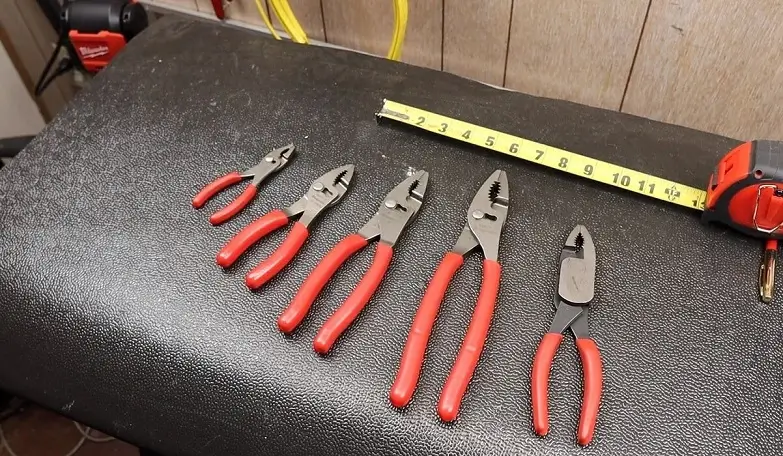Slip joint plier usage stands as a timeless classic—a reliable companion for countless DIY enthusiasts, tradespeople, and homeowners alike. Perfect for gripping, bending, and cutting, The slip joint plier is a must! Let’s learn why.
I will delve into the world of slip joint pliers, exploring their design, functionality, and the wide range of tasks they excel at. By understanding the ins and outs of slip joint pliers, you’ll be well-equipped to tackle various projects with confidence and efficiency.
What is a Slip Joint Plier?
Slip joint pliers, also known as adjustable pliers or water pump pliers, are a type of hand tool designed to grip, hold, twist, or turn objects of various sizes. They feature an adjustable pivot point that allows the user to change the width of the jaws, enabling them to accommodate different-sized objects. Slip joint pliers typically have serrated jaws with angled teeth that provide a secure grip on materials, preventing slippage during use.
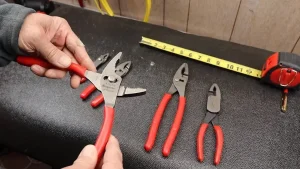
Types of Slip Joint Pliers
There are several types of slip joint pliers available, each designed to serve specific purposes. Here are a few common types:
Standard Slip Joint Pliers: These are the most common type of slip joint pliers. They feature a straight jaw with serrated teeth and an adjustable pivot point for varying the jaw width. Standard slip joint pliers are versatile and suitable for a wide range of tasks.
Tongue and Groove Pliers: Also known as Channellock pliers (after the popular brand), these slip joint pliers have a unique tongue and groove joint design. The jaw width can be adjusted by sliding the pivot along the grooves, providing a secure grip on objects. Tongue and groove pliers are known for their extra strength and are often used for heavy-duty applications.
Pump Pliers: Pump pliers, sometimes referred to as water pump pliers, have a curved jaw with angled teeth. They are designed specifically for gripping and turning pipes, plumbing fittings, and other cylindrical objects. The curved jaw allows for a better grip around rounded surfaces.
Long-Nose Slip Joint Pliers: These pliers have a slender and elongated jaw, tapering to a pointed tip. They are ideal for accessing tight spaces, handling small objects, and performing delicate tasks such as bending wires or holding small components.
Locking Slip Joint Pliers: Similar to locking pliers, these slip joint pliers have a built-in locking mechanism that allows them to maintain a secure grip without continuous hand pressure. The locking feature is especially useful when working on repetitive tasks or when a constant grip is required.
Wire Stripping Slip Joint Pliers: These pliers have additional features, such as built-in wire strippers and cutters. They are specifically designed for electrical work, allowing for easy stripping of insulation and cutting wires to size.
These are just a few examples of slip joint pliers available in the market. Each type has its unique features and advantages, catering to various applications and user preferences. It’s important to choose the appropriate type of slip joint pliers based on the specific task at hand.
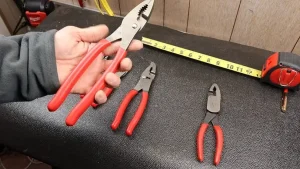
| Part | Function |
|---|---|
| Handles | Where you hold the plier. They sometimes have soft covers. |
| Jaws | The part that grips things. They move in and out. |
| Pivot Point | It’s like a knee. It helps the jaws open and close. |
| Adjustment Slot | This slot lets you change the jaw size. |
How to Use Slip Joint Pliers
It’s easy to use these pliers! Follow these steps:- Open the handles to adjust the jaws.
- Slide the jaws to get the size you want.
- Grip the object with the jaws.
- Squeeze the handles. This makes the jaws hold tight.
- Turn or pull to do your job. Easy!
Why Do We Love Slip Joint Pliers?
- They are super adjustable.
- You can use them on lots of different things.
- They are strong and last long.
- They can grip, cut, and bend.
Safety Tips
Safety is key! Here’s how to stay safe:- Always wear safety glasses.
- Don’t use pliers with worn-out grips.
- Make sure the jaw size fits what you’re working on.
- Check the plier before you use it. It should be clean and tight.
Choosing the Right Slip Joint Plier
Look for these things when you pick a plier:- Good handle grips for comfort.
- Adjustable sizes that fit your needs.
- Sturdy materials for a long life.
- The right size for your hand.
Caring for Your Pliers
Take care of your pliers and they’ll last! Do these things:- Keep them clean and dry.
- Oil the pivot point sometimes for smooth opening.
- Store them in a cool, dry place.
- Check the adjustment slot for easy movement.
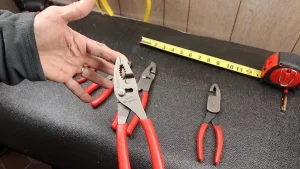
Common Tasks For Slip Joint Plier Usage
Slip joint pliers are highly versatile tools that can handle a wide range of tasks. Here are some common applications where slip joint pliers prove useful:
Gripping and Turning: Slip joint pliers excel at gripping and turning objects such as nuts, bolts, and fasteners. The adjustable jaw width allows them to accommodate different sizes, providing a secure grip for tightening or loosening.
Holding and Bending Wires: Slip joint pliers are handy for holding and bending wires during electrical work. The serrated jaws provide a firm grip, allowing you to manipulate wires with precision.
Adjusting Plumbing Fittings: Slip joint pliers are frequently used in plumbing tasks. They can tighten or loosen various plumbing fittings, such as nuts, couplings, or compression rings, making them essential for repairs and installations.
Cutting Soft Materials: Although slip joint pliers are not primarily designed for cutting, they can be used to cut softer materials like plastic tubing, wires, or zip ties in a pinch. However, it’s worth noting that specialized wire cutters or diagonal pliers are more suitable for precise cutting tasks.
Holding and Pulling Objects: Slip joint pliers can be employed to hold objects firmly while pulling or prying. Their adjustable jaw width allows for a customizable grip, making them helpful in various scenarios.
Removing or Installing Cotter Pins: Slip joint pliers can be used to remove or install cotter pins—a type of fastener often found in mechanical assemblies. The pliers’ jaws can grip the pin securely, facilitating easy insertion or extraction.
Forming or Straightening Small Metal Components: The pointed jaws of long-nose slip joint pliers make them ideal for bending or straightening small metal components, such as hooks, wires, or jewelry findings.
Assisting with Automotive Repairs: Slip joint pliers can be valuable in automotive maintenance and repairs. They can help with tasks like removing battery terminals, adjusting brake components, or manipulating hoses and clamps.
Remember to use slip joint pliers within their intended capacity and avoid applying excessive force that could damage the tool or compromise safety. Always refer to the manufacturer’s guidelines and exercise caution when using any hand tools.
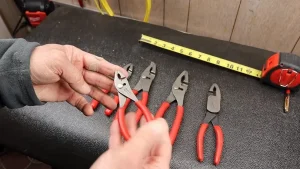
Frequently Asked Questions For Slip Joint Plier Usage:
What Is A Slip Joint Plier Used For?
A slip joint plier is a versatile tool used for gripping, bending, and cutting wire, as well as holding and manipulating objects of various sizes due to its adjustable pivot point.
How To Adjust Slip Joint Pliers?
To adjust slip joint pliers, align the pivot slot to the desired width position and gently close the handles until the pivot aligns with the chosen notch.
Can Slip Joint Pliers Cut Wire?
Yes, many slip joint pliers are equipped with cutting edges that can trim wire, although they are not primarily designed for cutting.
What Distinguishes Slip Joint Pliers?
Slip joint pliers stand out due to their adjustable jaw width, which allows them to grip objects of different sizes, making them a flexible tool in various applications.
In summary, slip joint pliers are indispensable tools that offer versatility, efficiency, safety, and cost savings. Slip joint plier usage is of paramount importance for anyone involved in DIY projects, repairs, or various trades. Understanding the capabilities and applications of slip joint pliers allows individuals to work more efficiently, safely, and with greater precision.

